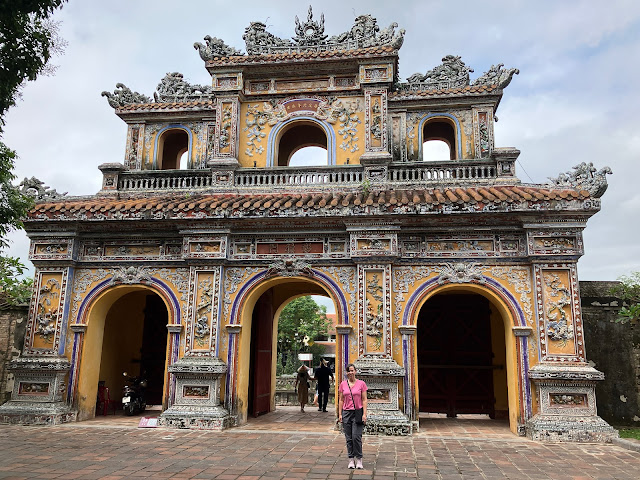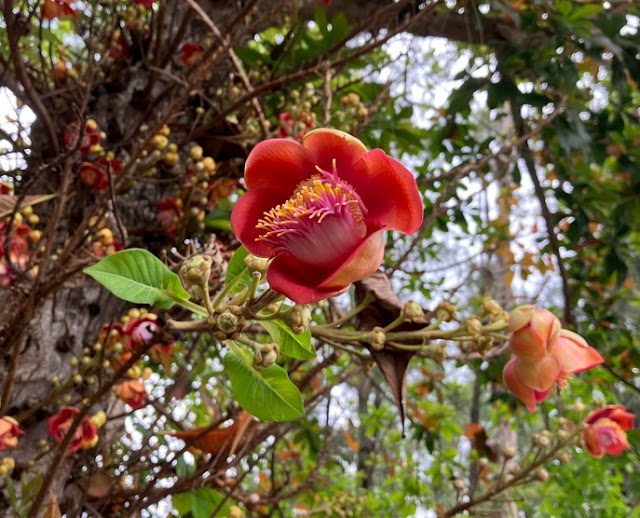We flew from Hanoi to the charming city of Hue in central Vietnam. People have been living in this area for over 2000 years; from 1802 to 1945 this was actually the capital of Vietnam, and during the Vietnam War this was the site of one of the longest and bloodiest battles due to its location near the border between north and south. But now it is a peaceful and touristic city, known for its UNESCO World Heritage-listed monuments, pagodas, and tombs. It is also known for its beautiful incense market. Each joss stick has a bright color indicating the scent of the incense. The rainbow-like displays in town are very eye-catching.
The Perfume River meanders through the middle of town. Dragon boats will take you on a one hour cruise to view the city from the water while listening to a traditional folk music performance.
The Song Huong River got its nickname “Perfume River” because the orchids growing along the riverbanks used to fall into the water making the river fragrant with their scent. I’m not sure that still holds true today, but orchids are still found throughout the region. In fact the city held a “most beautiful Orchid” competition and hung the entries throughout the old citadel. This one was the winner.
Hue was the home to the Nguyen Emperors — the last Imperial dynasty in Vietnam. In 1803 the first Nguyen emperor Gia Long built an Imperial complex consisting of three enclosed areas— an inner “forbidden city” (only the Emperor, his concubines, and the eunuch servants were allowed access), then surrounding it was an imperial city (where the mandarins and other officials worked and met with the Emperor), then a walled citadel surrounded the entire complex that was protected by soldiers. Here we are at the Meridian Gate which is the main entrance on the south side of the citadel next to the river.
Access to the inner imperial city was strictly controlled. Men and women entered through different gates. This is the Women’s Gate, on the west side of the city.
From 1802 to 1883, the Nguyen Empire ruled Vietnam mostly autonomously. During this time, the emperors expanded the kingdom as far as Laos and parts of Cambodia. The 2nd Emperor Minh Mang cut off many ties to Europe and focused on building a strong centralized government in his capital. But after his death in 1841, the empire began to decline as subsequent Emperors were not as ambitious or powerful and they failed to keep the country unified. From the 1860s to the 1880s the French began a campaign that saw them gradually conquer and colonize all the Vietnamese provinces. After 1883, the Emperors who ruled were either short-lived (some reigned only days or months until they were poisoned or deposed), or they ruled as puppets of the French colonial government. The last Emperor had no choice but to abdicate in 1945, transferring power to the Viet Minh and ending the Vietnamese empire -- he lived in exile in France until his death in 1997.
Our guide Thuy took us to the tomb of the second Emperor, Minh Mang. He ruled before the French colonial period and was considered a good ruler in his time. He upheld Confucian ideals, had very Vietnamese-centric policies that included isolation from Western Europe and the influence of other countries, and opposed the spread of Christianity and Catholicism in his country. He built highways to connect his empire, established a postal service, and attempted to stamp out corruption in his government. His tomb is about 20 minutes south of Hue city -- a huge mound of earthworks, just beyond a half-moon lake. The burial location of his body is secret; it’s not necessarily under the huge hill behind us but it could be anywhere in the gardens or landscaped terraces on the 44-acre site.
Statues of servants and mandarins (and horses and elephants) keep eternal watch over the resting place.
There are seven imperial tombs in the Hue area (the last emperor was exiled to France and is buried there, and several tombs are shared between multiple emperors). Our tour also included a visit to the tomb of the penultimate Emperor Khai Dinh. The names are complicated to remember even for the Vietnamese so they refer to them by number. This one is “Number Twelve”. You can see his photograph on the altar dedicated to his veneration.
If they were lucky to reign for a long enough time, the Emperors were able to design and oversee construction of their own tombs. Number Twelve was a puppet Emperor installed by the French and he reigned for a little over nine years. With his close ties to the French, his design for his final resting place was heavily influenced by French Gothic architecture. The exterior of his tomb looks like a French chateau that has been transported to Vietnam and reworked with an Asian flair. When constructed it was intentionally artificially aged to look as though it had already existed for centuries.
Number Twelve was a very theatrical man. He often dressed ostentatiously, wore cosmetics, and according to legend he never visited his concubines. (Remember, this was the 1920s, a very different era from nowadays). It is rumored that the last Emperor, number Thirteen, was not actually his son because 13 was quite tall while 12 was quite short. Regardless, the flamboyant personality of Emperor Khai Dinh shines through in the ornate decor of his tomb’s interior. It is covered top to bottom with ornate ceramic mosaic tiles intricately assembled in a visual cacophony of colors.
Our tour took us to one additional stop: the Thien Mu Pagoda complex, orignally built in 1601 and continually expanded and restored. It has seven levels and you used to be able to go inside, but it’s closed nowadays due to safety concerns. Besides it was so crowded that I can’t even imagine trying to climb seven flights of ancient stairs behind a thousand other people— the pagoda just isn’t big enough to handle these kinds of crowds. (As we approached the parking lot and saw all the tour busses, even our guide Thuy was amazed -- she started snapping photos of how crowded the parking lot was to send them to her boss).
Inside the temple complex was a tree with large interesting blooms. Our guide called it a Sala but it is more likely that it's a Cannonball Tree (imported from South America) based on the flower. According to Buddhist legend, Gautama Buddha was born under a Sala tree. Either way, the flowers of the tree were uniquely beautiful.
There were several reasons for all of the crowds in Hue. First, it was a weekend with three holidays in a row: Hung King festival, followed by Reunification Day, then the International Labor Day on May 1st. Plus, Hue is hosting a bi-annual Traditional Craft Festival from April 28 to May 5. We walked down to the river to have a look and it was really cool - this wasn’t just ticky-tacky souvenirs but master wood carvers, cabinetmakers, metalsmiths, silk painters and other traditional artisans displaying and selling high-end works.
We loved the many colorful signs placed around the area celebrating the cultural festival.
One of the tailors hosted a beautifully-coordinated fashion runway showcasing traditionally-designed Vietnamese clothing.
Later in the evening we walked around the old quarter, which closes several streets every night so that pedestrians can more easily walk to bars and restaurants. Hue was definitely a nightlife city — I’m not sure if it was just because of the holiday or if it was normal weeknight craziness but bars were packed and nightclubs were pumping out crazy loud music.
Our hotel was just behind two popular ones — HotTuna and 912 Factory Bar. Luckily our room faced behind the hotel so it was relatively quiet.
For our final night in Hue we booked an evening food tour. Usually these types of tours are walking tours but this one went by cyclo. You might be asking “What is a cyclo?” Good question! It’s a three-wheeled bicycle sedan chair taxi.
I’m not going to sugarcoat it — I initially had reservations that this was maybe not the safest way to get around town. The cyclos ride in the streets with all the other car and motorbike traffic -- there are no "bike paths" here. (Kevin said his driver kept going “Whooooah!” whenever oncoming traffic got too close.) There were definitely a couple of exhilarating intersections that appeared to have a "no rules" approach to determine right-of-way.
But overall we just had to trust that our cyclo drivers (and the drivers of all the other vehicles on the road) knew what they were doing. There are definitely unspoken rules of the road here in Vietnam; I just haven't been able to figure them out so I was glad I wasn't the one driving or cycling!
And it all turned out okay -- our small group of four guests and our guide Thom got everywhere we needed to go safely.
We tried some really delicious Hue foods, like Bun Bo Hue (beef noodle soup), Bun Thit Nuong (grilled pork noodle salad), and Banh Khoai (crispy rice pancake filled with veggies and shrimp). But there were also some interesting dishes that I was happy to just try once, like the gelatinous Banh Nam traditional dumpling that was served in a leaf with a shrimp embedded inside shell and all. You are supposed to eat the shell — and I did — but it was definitely not a favorite and I won’t be serving that one at my next dinner party.
At the end of the evening Thom brought us all to his home for beers and some home-cooked food prepared tableside by his very talented wife. It was a fun evening and we enjoyed meeting his family and eating some amazing grilled chicken, pork, and shrimp. Such a nice and memorable way to end our time in this scenic and lively town. I think I can definitively say that of all the places we’ve visited in Vietnam on this trip, Hue has been my favorite by far.
























No comments:
Post a Comment